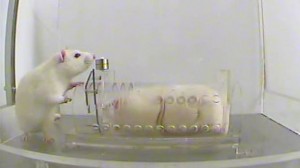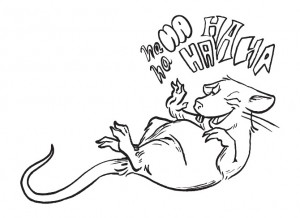Unfortunately, scientists have not discovered a rodent that can talk and dresses up as a human. However, they have discovered that rats can experience humanistic emotions and exhibit human characteristics.

The test rat in the process of freeing the imprisoned rat.
Source: http://www.cbc.ca/news/offbeat/story/2011/12/09/rats-empathy-chicago.html
Inbal Ben-Ami Bartal et al. at the University of Chicago have found that rats have the ability to show empathy towards other rats. The research team’s experiment was designed to test whether a rat would open a cage to free another comrade inside. The results showed that the tested rat would free their distressed companion when it hears its calls, regardless of rewards. In order to further test this empathetic behaviour, the researchers performed trials where they placed chocolate in another container nearby to see if the test rat will head to the food instead of the imprisoned rodent. Surprisingly, instead of the anticipated results, the test rat chose to free the restrained rat. Furthermore, instead of hoarding the chocolate, the test rat went as far as to share it with the other. As such, not only have rats shown empathy in this experiment, they also appear to retain a pro-social behavior towards other rats which is reminiscent of behavior recognized in our culture.
Another finding that exhibits human characteristics found in rats was conducted by Jaak Panksepp, a neuroscientist at Washington State University. He discovered that when tickled, rats emit chirps that are akin to laughter heard through Bat Detectors, a device that can bring high frequencies to our auditory range. These 50 kHz chirps were found to be related to positive affective state in rats (Burgdorf 2011) and can also be heard when the rodents play and chase each other.

So why should people care whether rats can show empathy or laugh when tickled? These discoveries allow scientists to understand how the brain of specific animal works and its subsequent effect on behavior. Although these studies are focused on rats, the same experimental research may be applicable to other animals as well. This may in turn resolve some of the mysteries of the animal kingdom, from the process that fuels their keen instincts to the impulse that drives certain behaviours.
If further discoveries are made, perhaps we may one day see a genuine Stuart Little that can communicate with us. On the other hand, we might find a duo Pinky and the Brain and stop them from taking over the world.
Blog post submitted by: Tiffany Ho
References:
Burgdorf, Jeffrey, Jaak Panksepp, and Joseph R. Moskal. “Frequency-Modulated 50 kHz Ultrasonic Vocalizations: A Tool for Uncovering the Molecular Substrates of Positive Affect.” Neuroscience and biobehavioral reviews 35.9 (2011): 1831-6. Print.



One response to “A Step Towards Finding Stuart Little?”